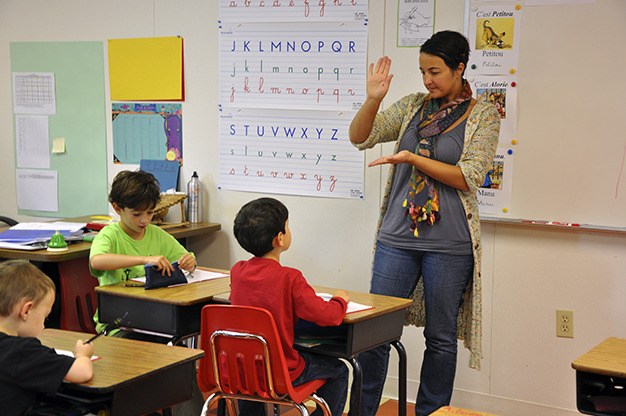With a pencil in hand, shaping lowercase and uppercase cursive letters between the lines has traditionally been part of a child’s elementary education. It may be tedious for some, or something to take pride in for others.
While Mercer Island public schools continue to offer cursive instruction, it is undergoing a review this year. Language arts is being reviewed with the implementation of the Common Core curriculum. The Common Core does not require cursive, does not address print, and only addresses legibility.
Cursive is introduced in second grade at Island public schools, and revisited in third grade. After learning both print and cursive, students can choose their own preference as they continue through school.
“All of our handwriting will be under review, as part of the language arts review,” Fred Rundle, Mercer Island School District director of learning services, said.
The debate over the necessity of cursive writing in this digital, technological era is ongoing. A College Board study found that students who wrote in cursive for the essay portion of the SAT scored higher than students who printed.

“I think it’s about keyboarding and handwriting and where those two intersect, and we have to consider those bodies of research that are out there,” Rundle said. “There are some that indicated handwriting and cursive are very important skills for kids to acquire.”
The other extreme is all about technology, with no place for cursive.
“We don’t have a stance on that as a district right now because that’s going to be all part of our review,” Rundle said.
In the English and language arts portion of the Common Core curriculum, readability levels are changing, Rundle said. There will be changes in expectations for what students are able to read and comprehend, he explained.
People think that English and language arts are traditionally about reading and writing, Rundle said. But with Common Core it will be more: speaking, listening, how to communicate effectively.
At the French American School of Puget Sound, cursive is being taught in kindergarten and first grade.
“Our students continue their French handwriting throughout their experience at FASPS usually even when given the choice in the upper grades,” said Elli Gildnes, the assistant head of English curriculum.
FASPS is accredited by the French Ministry of Education, which requires teachers to teach cursive beginning in kindergarten.
 Children ages 3 and 4, in the FASPS Young Pre-Kindergarten and Pre-K program, begin uppercase block printing. Kindergartners learn uppercase block printing until January, and then begin lowercase cursive — taught in French and reinforced by an English teacher, Gildnes said.
Children ages 3 and 4, in the FASPS Young Pre-Kindergarten and Pre-K program, begin uppercase block printing. Kindergartners learn uppercase block printing until January, and then begin lowercase cursive — taught in French and reinforced by an English teacher, Gildnes said.
“It’s all about circles and lines, always,” Cécile Chapel, a first-grade teacher, said. By the end of kindergarten, students can write their names and a few words in cursive. When they arrive in first grade, they know all the letters, Chapel said.
First-graders begin uppercase cursive with their French teacher, and lowercase printing with their English teacher. Graphilettre is used for first-graders. Kids begin with the basic movement of the hand. Then, they start forming large letters, working toward very small letters. FASPS orders special notebooks from France.
“During their work, they need to be able to always right in cursive,” Chapel said. “To start with, it’s always four lines.”
Presenting their work properly is important, she said.
“We try to put cursive and print everywhere so they know how to go from one to another very fast,” Chapel explained.
At St. Monica School, cursive is not being taught this year.
“The children keyboard mostly,” Anca Wilson, St. Monica principal, said. “They do use handwriting, but mainly printing, so for the past several years there has been a shift away from cursive. This year, the teacher said she’d rather put that time into word study and teaching Phonics than cursive.”
While Wilson and third-grade teacher Mrs. Malone feel that cursive is a good thing, they view it as obsolete.
“Cursive takes a lot of practice. We find that parents don’t practice at home with the kids,” Wilson said. “Personally, I’m sad to see it go, but we have to think in terms of what’s relevant.”
Cursive, however, helps with efficiency at FASPS.
“We believe it goes faster because it is always one movement,” Chapel said. “Each word is a different block; you can see the segmentation. In print, visually, it’s not as segmented.”
Last week, a first-grader told Chapel that her dad showed her the Declaration of Independence, which was written in cursive.
“She was so excited she could recognize the letters,” Chapel said.
Top, Parker Doucette writes in Molly Harnish’s second-grade class at West Mercer Elementary (Randy Bolerjack/Contributed Photo). Below, a first-grader at the French American School of Puget Sound takes a spelling test in cursive in the ‘cahier du jour’ (Rebecca Mar/Staff Photo).



